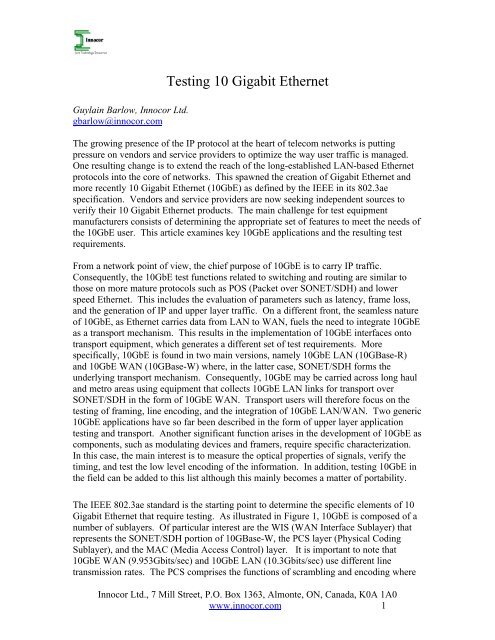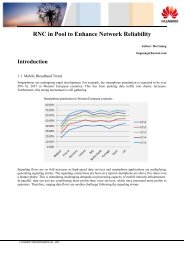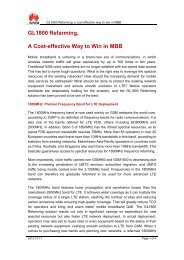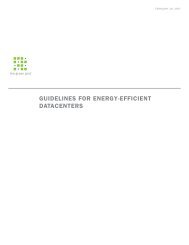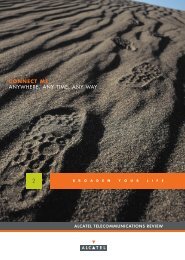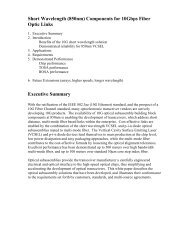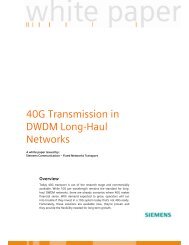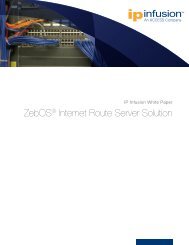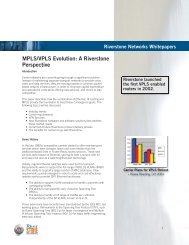Testing 10 Gigabit Ethernet - Light Reading
Testing 10 Gigabit Ethernet - Light Reading
Testing 10 Gigabit Ethernet - Light Reading
You also want an ePaper? Increase the reach of your titles
YUMPU automatically turns print PDFs into web optimized ePapers that Google loves.
Guylain Barlow, Innocor Ltd.<br />
gbarlow@innocor.com<br />
<strong>Testing</strong> <strong>10</strong> <strong>Gigabit</strong> <strong>Ethernet</strong><br />
The growing presence of the IP protocol at the heart of telecom networks is putting<br />
pressure on vendors and service providers to optimize the way user traffic is managed.<br />
One resulting change is to extend the reach of the long-established LAN-based <strong>Ethernet</strong><br />
protocols into the core of networks. This spawned the creation of <strong>Gigabit</strong> <strong>Ethernet</strong> and<br />
more recently <strong>10</strong> <strong>Gigabit</strong> <strong>Ethernet</strong> (<strong>10</strong>GbE) as defined by the IEEE in its 802.3ae<br />
specification. Vendors and service providers are now seeking independent sources to<br />
verify their <strong>10</strong> <strong>Gigabit</strong> <strong>Ethernet</strong> products. The main challenge for test equipment<br />
manufacturers consists of determining the appropriate set of features to meet the needs of<br />
the <strong>10</strong>GbE user. This article examines key <strong>10</strong>GbE applications and the resulting test<br />
requirements.<br />
From a network point of view, the chief purpose of <strong>10</strong>GbE is to carry IP traffic.<br />
Consequently, the <strong>10</strong>GbE test functions related to switching and routing are similar to<br />
those on more mature protocols such as POS (Packet over SONET/SDH) and lower<br />
speed <strong>Ethernet</strong>. This includes the evaluation of parameters such as latency, frame loss,<br />
and the generation of IP and upper layer traffic. On a different front, the seamless nature<br />
of <strong>10</strong>GbE, as <strong>Ethernet</strong> carries data from LAN to WAN, fuels the need to integrate <strong>10</strong>GbE<br />
as a transport mechanism. This results in the implementation of <strong>10</strong>GbE interfaces onto<br />
transport equipment, which generates a different set of test requirements. More<br />
specifically, <strong>10</strong>GbE is found in two main versions, namely <strong>10</strong>GbE LAN (<strong>10</strong>GBase-R)<br />
and <strong>10</strong>GbE WAN (<strong>10</strong>GBase-W) where, in the latter case, SONET/SDH forms the<br />
underlying transport mechanism. Consequently, <strong>10</strong>GbE may be carried across long haul<br />
and metro areas using equipment that collects <strong>10</strong>GbE LAN links for transport over<br />
SONET/SDH in the form of <strong>10</strong>GbE WAN. Transport users will therefore focus on the<br />
testing of framing, line encoding, and the integration of <strong>10</strong>GbE LAN/WAN. Two generic<br />
<strong>10</strong>GbE applications have so far been described in the form of upper layer application<br />
testing and transport. Another significant function arises in the development of <strong>10</strong>GbE as<br />
components, such as modulating devices and framers, require specific characterization.<br />
In this case, the main interest is to measure the optical properties of signals, verify the<br />
timing, and test the low level encoding of the information. In addition, testing <strong>10</strong>GbE in<br />
the field can be added to this list although this mainly becomes a matter of portability.<br />
The IEEE 802.3ae standard is the starting point to determine the specific elements of <strong>10</strong><br />
<strong>Gigabit</strong> <strong>Ethernet</strong> that require testing. As illustrated in Figure 1, <strong>10</strong>GbE is composed of a<br />
number of sublayers. Of particular interest are the WIS (WAN Interface Sublayer) that<br />
represents the SONET/SDH portion of <strong>10</strong>GBase-W, the PCS layer (Physical Coding<br />
Sublayer), and the MAC (Media Access Control) layer. It is important to note that<br />
<strong>10</strong>GbE WAN (9.953Gbits/sec) and <strong>10</strong>GbE LAN (<strong>10</strong>.3Gbits/sec) use different line<br />
transmission rates. The PCS comprises the functions of scrambling and encoding where<br />
Innocor Ltd., 7 Mill Street, P.O. Box 1363, Almonte, ON, Canada, K0A 1A0<br />
www.innocor.com 1
each 64 bits of information are preceded by 2 synchronization bits. The MAC layer is<br />
virtually the same as for other <strong>Ethernet</strong> rates where upper layer information is<br />
encapsulated with a MAC header. MAC Frames are separated by idle bytes in the form<br />
of IFGs (Inter-Frame Gap), generally inserted at the RS (Reconciliation Sublayer).<br />
OSI Model<br />
Transport<br />
Network<br />
Data Link<br />
Physical<br />
Figure 1 <strong>10</strong> <strong>Gigabit</strong> <strong>Ethernet</strong> Model<br />
LLC<br />
MAC Ctlr opt.<br />
MAC<br />
RS<br />
XGM<br />
II<br />
64B/66B PCS<br />
PMA<br />
PMD<br />
MDI<br />
Fiber<br />
<strong>10</strong>GBASE-R<br />
LLC<br />
MAC Ctlr opt.<br />
MAC<br />
RS<br />
XGM<br />
II<br />
64B/66B PCS<br />
WIS<br />
PMA<br />
PMD<br />
MDI<br />
Fiber<br />
<strong>10</strong>GBASE-W<br />
Logical Link Control<br />
Media Access Control<br />
Reconciliation Sublayer<br />
<strong>10</strong> <strong>Gigabit</strong> Media<br />
Independent Interface<br />
Physical Coding Sublayer<br />
WAN Interface Sublayer<br />
Physical Medium Attachment<br />
Physical Medium Dependent<br />
Medium Dependent Interface<br />
Here is a deeper look at <strong>10</strong>GbE on transport equipment for which an example is shown in<br />
Figure 2. An important test device consideration is a unified, software switchable<br />
platform that provides <strong>10</strong>GbE WAN and <strong>10</strong>GbE LAN. In addition, support for lasers at<br />
different wavelengths and reaches based on MSA (Multi Source Agreement) technology<br />
provides flexibility. At least four <strong>10</strong>Gbits/sec MSA technologies exist on the market<br />
including XENPAK, its evolution to XPAK, XFP, and 300-pin MSA. The first two<br />
technologies use a XAUI electrical interface to connect into a <strong>10</strong>GbE device. While<br />
these interfaces are suitable for most equipment, they do not provide control over the<br />
PCS layer as the XAUI interface sits at the XGMII level as in Figure 1. For most<br />
transport users, the XFP or 300-pin MSA technologies are therefore preferable. XFP is<br />
an emerging technology not generally available at the time of this article. In addition,<br />
there will be optical power limitations especially at 1550nm. The 300-pin MSA<br />
technology satisfies transport test requirements; however, its main limitation is the fact<br />
that it is hot pluggable. Another aspect the transport user may consider are very long<br />
haul applications that use digital wrapping and FEC (Forward Error Correction)<br />
techniques to extend signal reach. The emerging standard for this function is based on<br />
ITU-T G.709 that operates at <strong>10</strong>.7Gbits/sec for OC-192/STM-64. A similar standard that<br />
supports <strong>10</strong>GbE LAN long distance transport, will likely arise since current<br />
implementations are proprietary and difficult to test independently.<br />
Innocor Ltd., 7 Mill Street, P.O. Box 1363, Almonte, ON, Canada, K0A 1A0<br />
www.innocor.com 2
<strong>10</strong>GbE LAN<br />
<strong>10</strong>GbE LAN<br />
OC-192/STM-64<br />
(<strong>10</strong>GbE WAN)<br />
Figure 2 Transport Equipment Sample Configuration<br />
The following provides a comprehensive test feature list that as applicable to <strong>10</strong>GbE<br />
interfaces on transport equipment.<br />
Payload Test Patterns: robust PRBS (Pseudo Random Bit Sequence) test patterns provide<br />
bit level accuracy. These patterns are preferable to straightforward CRC validation,<br />
which provide frame level error detection.<br />
PCS coding layer: the test equipment should ideally detect block errors, report rates and<br />
be able to inject such errors. In addition, the test equipment should control sync header<br />
bits to inject and detect High BER (Bit Error Rate) and Loss of Lock alarms.<br />
Faults: Remote Faults and Local Faults ordered sets provide fault detection mechanism.<br />
Detection and injection are of interest to the transport user.<br />
MAC Layer Errors: capabilities to fully exercise MAC include CRC controlled error<br />
injection and monitoring. Frames of multiple sizes shall also be provided including<br />
undersized, jumbo and oversized. Support for <strong>Ethernet</strong> Type II and 802.3 shall be<br />
provided along with VLAN.<br />
Bandwidth Control: this refers to tight control over Inter Frame Gap (IFG) sizes<br />
including IFGs below the allowable limits.<br />
Flow control features: this ensures matching traffic rates between the LAN (<strong>10</strong>.3Gbps)<br />
and WAN (9.953Gbps) interfaces. This is accomplished via MAC pause frames or<br />
ifsStretch capabilities.<br />
WIS layer testing: this is the same as testing SONET/SDH. This includes B1, B2, B3<br />
error rates, SONET/SDH alarms, and overhead bytes.<br />
Disruption Time Measurements: in the event of protection switching, the response<br />
offered by the network equipment should be measurable.<br />
Clock synchronization: this includes the options to provide internal clock timing, line<br />
timing, and clock rate variations of up to +/-<strong>10</strong>0ppm for <strong>10</strong>GbE LAN.<br />
The upper layer applications supported by routing, switching, and even storage devices<br />
generate different test needs. Two main categories of test can be defined in the form of<br />
data plane and control plane testing. Data plane requirements, especially in the case of<br />
<strong>10</strong>Gbps rates generally involve a large number of dedicated hardware resources.<br />
Conversely, control plane testing involves significant software based features. Here are<br />
sample requirements for upper layer testing.<br />
Protocol support: this includes protocols such as IPv4, IPv6, TCP, UDP, IGMP, ARP,<br />
and involves the edition of header and payload fields.<br />
Traffic streaming: refers to the generation of multiple traffic streams, each with its own<br />
Innocor Ltd., 7 Mill Street, P.O. Box 1363, Almonte, ON, Canada, K0A 1A0<br />
www.innocor.com 3
protocol and bandwidth definitions. This includes the support of multiple MAC and IP<br />
addresses to emulate traffic from multiple sources and destinations.<br />
Quality of Service: includes the evaluation of latency and packet jitter based on injected<br />
timestamps. In addition, sequence numbering will identify out-of-sequence packets and<br />
packet loss.<br />
Filtering: allows for the reporting of statistics based on groups of packets.<br />
Buffer captures: empower users to capture packets and save them for later retrieval.<br />
Protocol decodes may also be performed on the captured data.<br />
Control plane testing refers to the conformance to standards and the performance testing<br />
of routing protocols. Examples include the testing of OSPF, BGP, and MPLS specific<br />
protocols such as LDP, CR-LDP, and RSVP-TE.<br />
One the <strong>10</strong>GbE component testing front, the requirements to test framing devices center<br />
around detailed PCS and MAC features and potentially an electrical interface although<br />
optical to electrical conversion may be performed. On the modulating device front, such<br />
as transponders, test functions include: evaluation of OSNR (Optical Signal to Noise<br />
Ratio), stressed eye testing accomplished by adding noise to the optical signal, jitter<br />
tolerance generation and measurements, and receiver sensitivity. These tests generally<br />
involve a dedicated hardware test platform and the generation of 802.3ae test patterns<br />
such as square wave, mixed patterns, and PRBS31. The main reason is the specificity of<br />
these tests.<br />
The broad spectrum of test requirements listed above puts pressure on test equipment<br />
manufacturers to address the largest market possible. In many cases, test requirements<br />
stretch the hardware capabilities of the equipment and this poses technical challenges. It<br />
remains that <strong>10</strong>GbE test devices are designed to address specific target markets and<br />
applications. Innocor’s designed its Testpoint TM Tsunami shelf platform and the SM-<br />
9953EX single-slot system to support test applications for the <strong>10</strong>GbE transport market,<br />
the upper layer manufacturing space, and to cover low level functions for the framer<br />
component market. In addition, Innocor’s products test a range of functions from<br />
SONET/SDH, G.709, <strong>Gigabit</strong> <strong>Ethernet</strong>, ATM, POS while integrating functions such as<br />
optical switching devices. Innocor offers low cost, robust platforms and a high level of<br />
integration.<br />
For more information about Innocor's tester and IP core solutions, visit the Innocor web<br />
site at www.innocor.com or e-mail info@innocor.com.<br />
Innocor Ltd., 7 Mill Street, P.O. Box 1363, Almonte, ON, Canada, K0A 1A0<br />
www.innocor.com 4


